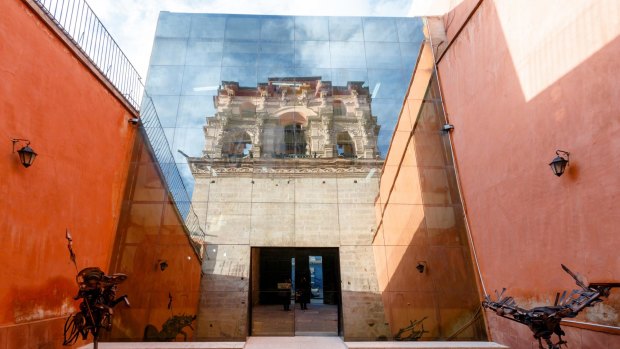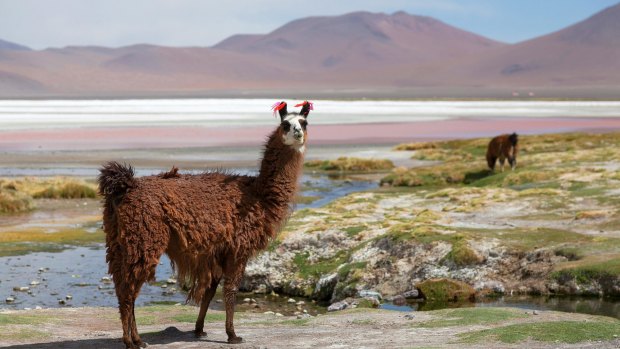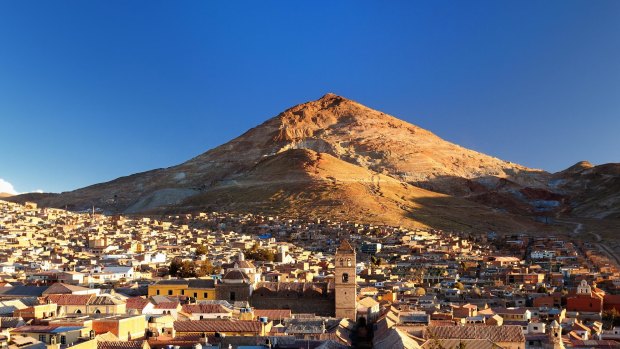This was published 5 years ago
Potosi, Bolivia: A city built on silver and surrounded by natural wonders
By Ute Junker

The Torre de la Compania de Jesus.Credit: Shutterstock
At first glance, there is nothing to distinguish Potosi, with its narrow streets and its lively undercover market, from dozens of other colonial cities across South America. Its most defining feature appears to be its isolation, perched on a remote plateau 4000 metres above sea level and more than 500 kilometres from La Paz.
Follow those cobblestone streets into the heart of town, however, and Potosi turns out to be a treasure trove of impressive architecture. From the imposing Plaza 10 de Noviembre to the dazzling San Lorenzo de Carangas church, its limestone facade decorated with ornate carvings combining religious and indigenous motifs, these buildings are relics of a time when Potosi was the most important – and richest – city in the Americas.
It wasn't just the buildings that were grand. During the city's 17th-century heyday, Potosi's elite enjoyed a lifestyle as sumptuous as any in Europe. Their mansions were fitted out with carpets from Persia, paintings from Italy and silk from China. The source of their wealth? Cerro Potosi, sometimes called Cerro Rico, the mountain that still rises behind the town to this day. The conquistadors may have to come to South America in search of the proverbial rivers of gold, but in Cerro Potosi, they found a literal mountain of silver.

Lama on the Laguna Colorada.Credit: Shutterstock
The mountain's veins of silver had already been mined under the Incans, but the Spanish industrialised operations. Inside Potosi's historic mint, now a museum called the Casa de la Moneda, a range of exhibits explains how, over several centuries, more than 40,000 tons of silver was mined and transformed into coins. The mining was done by a conscript workforce of indigenous people and African slaves, who died in droves. The milling involved more than100 hydraulic mills. Mules drove the coin presses, which could produce 7000 coins in a single day.
The money made its way back to Spain through the so-called silver trails, routes that wound their way through the surrounding high-altitude desert all the way down to ports on the Pacific and Atlantic coasts, from where the silver was shipped to Spain. The logistics were extraordinary. Huge caravans of llamas – up to 15,000 beasts a train – would set out from Potosi, each animal laden with 25 to 30 kilos of silver. The caravans would cover about 30 kilometres a day; every afternoon, they would pull in at camps where fresh llamas were waiting for the next day's journey. To prevent their precious cargo being stolen, the workers would sleep in a circle, the silver in the centre and the llamas on the outside; the easily-alarmed animals provided plenty of notice of any approaching marauders.
The llama trains are long gone, but today intrepid travellers can follow these same trails to discover a different kind of treasure. This remote corner of Bolivia is home to some of South America's most unforgettable landscapes. The most famous is Uyuni, which is well-known for its otherworldly salt flats, 10,000 square kilometres of blindingly-white plains punctuated by cactus-studded islands. Less well-known but no less remarkable is Uyuni's train graveyard, an atmospheric collection of ruined trains that look like something out of a Mad Max film.

Potosi, Bolivia and Cerro Rico, the mountain that made it rich. Credit: Shutterstck
Uyuni is just the start. Take a couple of days to explore the National Reserva Eduardo Avaroa, a collection of Martian-style landscapes where a new wonder lies around every corner, from soaring snow-capped volcanoes to bubbling thermal pools and desert plains filled with rocky outcrops eroded into Dali-esque shapes. Keep an eye out for the region's distinctive wildlife, including herds of vicunas and the rabbit-like viscacha.
The area's most striking sight, however, is its colourful lagoons, which draw their unusual hues from their rich mineral content. It is hard to pick which one is loveliest; perhaps the shimmering green Laguna Verde, or the rusty red Laguna Colorada. Arrive in the early morning, when temperatures are still hovering just above zero, and you will find the lagoons filled with large numbers of flamingos. The birds sleep standing in the water, where they know they are safe from predators. The downside? As the lake freezes during the night, they are trapped there until the ice melts the next morning. That's life in the altiplano, where only the strongest survive.
Ute Junker travelled as a guest of LATAM Airlines and Adventure World.
TRIP NOTES
MORE
FLY
LATAM operates seven one-stop flights each week from Sydney to Santiago, Chile, with onward connections to Bolivia, and three non-stop flights a week from Melbourne to Santiago. See latam.com/en_au/
EAT
The family-run El Emperadradrillo serves up local specialties include kallapurca, or volcano soup, a bubbling corn stew served with a heated volcanic stone in the bowl. See facebook.com/el-empedradillo
TOUR
Adventure World Travel offers a number of Bolivian itineraries. Its six-night Handpicked Bolivia, which takes in La Paz, Lake Titicaca, Uyuni and the salt flats, can be customised to include Potosi and the National Reserva Eduardo Avaroa. From $3349 a person, including accommodation, meals as in the itinerary, sightseeing with a local English-speaking guide, all transfers and flights. See adventureworld.com
Sign up for the Traveller Deals newsletter
Get exclusive travel deals delivered straight to your inbox. Sign up now.